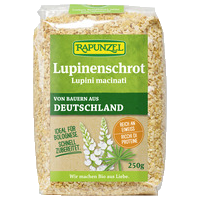
Lupin crushed
The differences between yellow, white and blue lupine are not only limited to the flower color, but the varieties also differ with respect to the demands on the soil, the climate and the cultivation technique, their yield as well as their maturing time.
Yellow lupine has the lowest yield potential followed by blue lupine. White lupine has the best yield per hectare, but also the highest demands on soil quality. Botanically speaking, lupines belong to the subfamily of the papilionaceous plants within the legume family just like peas, chickpeas and peanuts.
The name "sweet lupine" is not derived from the sweet flavor but from bitter and poisonous lupinine compounds (nitrogen compounds) that were eliminated through breeding over the years. In earlier times, these active indgredients had to be removed through thorough rinsing and boiling in order to make lupines edible.
The name "sweet lupine" is not derived from the sweet flavor but from bitter and poisonous lupinine compounds (nitrogen compounds) that were eliminated through breeding over the years. In earlier times, these active indgredients had to be removed through thorough rinsing and boiling in order to make lupines edible.
Domestic protein supplier with varied use
Cultivation and yield
The 1.5 m deep roots supply the plant well with nutrients, because the roots can absorb nutrients from deeper soil levels. At the same time, the roots accumulate nitrogen with their nodule bacteria which improves overall plant fertility.
Some lupine varieties are very undemanding that can grown on meagre, sandy soils. Lupines have not been genetically manipulated. Therefore, there is no risk of GMO contamination. Time of sowing and time of yield vary depending on variety. Blue lupine is sown from April to May and can already be harvested from August until September.
By the way: the seeds of garden lupines that can be seen in many gardens as white, pink and dark violet flowering ornamental plants are bitter and inedible.
Processing
After the harvest, the seedpods of the sweet lupine are removed by threshing. Susequently, the seeds are cleaned and processed (e.g. coarsely ground).
Nutritional physiology
Sweet lupine has a very high protein content of nearly 40 percent and a good protein valence. Additionally, the seeds are almost purine free and have fewer flatulent substances than other legumes, making sweet lupine particularly digestible. Moreover, sweet lupine sports very small concentrations of high-quality lipids, a good range of vitamins and minderal substances such as calcium, magnesium and iron.
What's special about Rapunzel sweet lupine groats?
Rapunzel sweet lupine groats are made with blue sweet lupine (Lupinus angustifolius) that is cultivated in Germany, Austria and Poland. This sweet lupine variety convinces with its nutty, sweet flavor and its strong bite.
We chose the blue lupine because this variety is well adapted to the climatic conditions and the soil conditions in the different growing regions (e.g. Northern Germany).
This domestic legume can be quickly and easily prepared and can be used in salads, in spreads, for paddies or as filling or as meat or soy substitute in Bolognese and lasagne.
